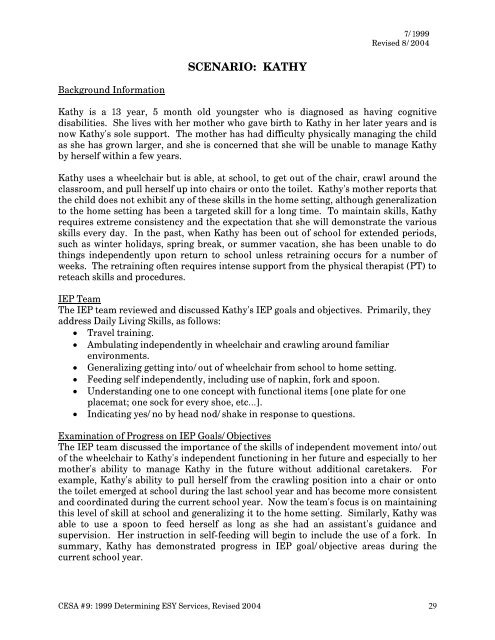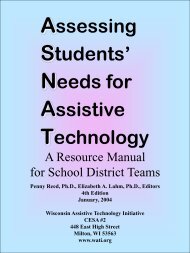Extended School Year Services (ESY) - The Special Education Team
Extended School Year Services (ESY) - The Special Education Team
Extended School Year Services (ESY) - The Special Education Team
Create successful ePaper yourself
Turn your PDF publications into a flip-book with our unique Google optimized e-Paper software.
Background Information<br />
SCENARIO: KATHY<br />
7/1999<br />
Revised 8/2004<br />
Kathy is a 13 year, 5 month old youngster who is diagnosed as having cognitive<br />
disabilities. She lives with her mother who gave birth to Kathy in her later years and is<br />
now Kathy's sole support. <strong>The</strong> mother has had difficulty physically managing the child<br />
as she has grown larger, and she is concerned that she will be unable to manage Kathy<br />
by herself within a few years.<br />
Kathy uses a wheelchair but is able, at school, to get out of the chair, crawl around the<br />
classroom, and pull herself up into chairs or onto the toilet. Kathy's mother reports that<br />
the child does not exhibit any of these skills in the home setting, although generalization<br />
to the home setting has been a targeted skill for a long time. To maintain skills, Kathy<br />
requires extreme consistency and the expectation that she will demonstrate the various<br />
skills every day. In the past, when Kathy has been out of school for extended periods,<br />
such as winter holidays, spring break, or summer vacation, she has been unable to do<br />
things independently upon return to school unless retraining occurs for a number of<br />
weeks. <strong>The</strong> retraining often requires intense support from the physical therapist (PT) to<br />
reteach skills and procedures.<br />
IEP <strong>Team</strong><br />
<strong>The</strong> IEP team reviewed and discussed Kathy's IEP goals and objectives. Primarily, they<br />
address Daily Living Skills, as follows:<br />
• Travel training.<br />
• Ambulating independently in wheelchair and crawling around familiar<br />
environments.<br />
• Generalizing getting into/out of wheelchair from school to home setting.<br />
• Feeding self independently, including use of napkin, fork and spoon.<br />
• Understanding one to one concept with functional items [one plate for one<br />
placemat; one sock for every shoe, etc…].<br />
• Indicating yes/no by head nod/shake in response to questions.<br />
Examination of Progress on IEP Goals/Objectives<br />
<strong>The</strong> IEP team discussed the importance of the skills of independent movement into/out<br />
of the wheelchair to Kathy's independent functioning in her future and especially to her<br />
mother's ability to manage Kathy in the future without additional caretakers. For<br />
example, Kathy's ability to pull herself from the crawling position into a chair or onto<br />
the toilet emerged at school during the last school year and has become more consistent<br />
and coordinated during the current school year. Now the team's focus is on maintaining<br />
this level of skill at school and generalizing it to the home setting. Similarly, Kathy was<br />
able to use a spoon to feed herself as long as she had an assistant's guidance and<br />
supervision. Her instruction in self-feeding will begin to include the use of a fork. In<br />
summary, Kathy has demonstrated progress in IEP goal/objective areas during the<br />
current school year.<br />
CESA #9: 1999 Determining <strong>ESY</strong> <strong>Services</strong>, Revised 2004 29











